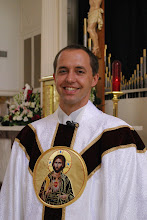
On our drive through the mountains to Nazareth, we saw a Druze village, enjoyed an Israeli Falaffel lunch as well as some nice views of snow capped mountains to the North.
We arrived at the Basilica of Annunciation in the early afternoon in time for a visit of the Cave which was Mary's home, the Basilica above it and Joseph's cave. Then we celebrated Holy Mass at the altar just in front of Mary's cave where the Angel Gabriel appeared to Mary. Afterwards, we enjoyed our first major shopping binge at a shop run by a local Catholic family who was very hospitable to us. Finally we headed to a very nice hotel on the outskirts of town to enjoy an large buffet and comfortable rooms. We also started our nightly prayer/reflection sessions with Evening prayer and giving thanks to God for the blessings of the day.



